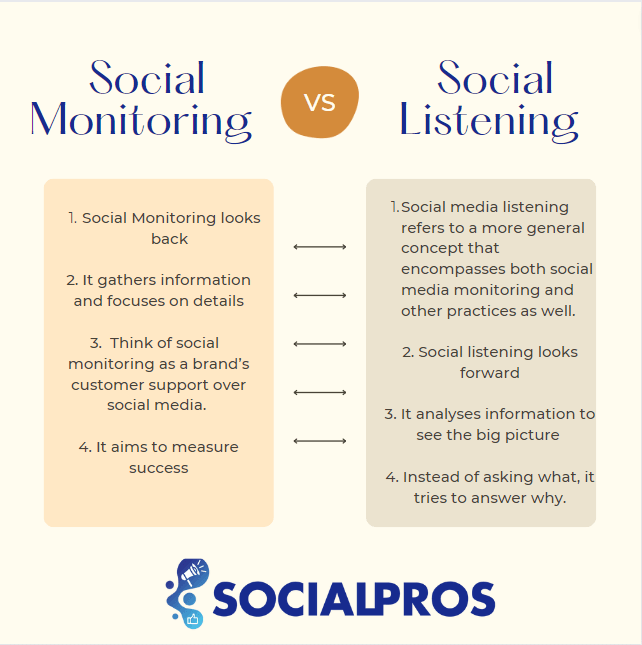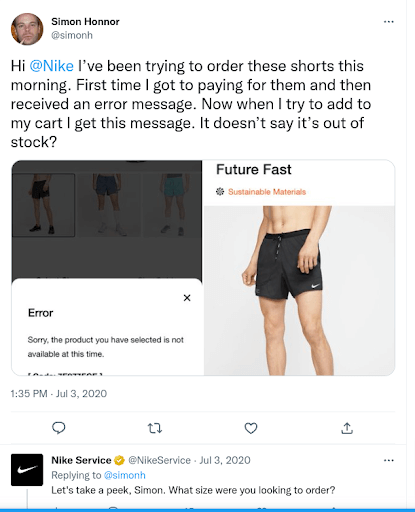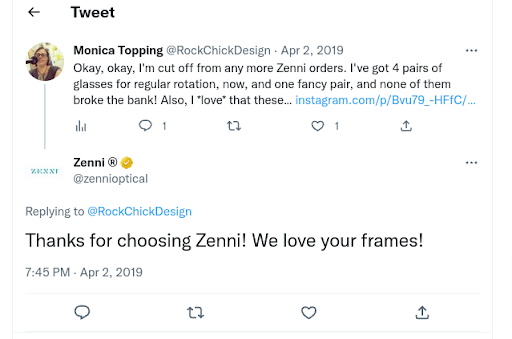Page Contents
Social listening, also known as social media listening, is an effective technique helping brands gain a deeper understanding of their audience and competitors. Moreover, Social listening can help track and monitor online conversations and mentions to identify your brand’s strengths and weaknesses.
If you have not already used Social Listening in your digital brand strategy, you are missing out on essential information that can significantly impact your online success.
Therefore, this post will explore the key steps you can take to improve your brand through social listening. In the following, we’ll talk about social listening and how it can be done more systematically. So, stay tuned as we go through the matter in more detail.
What Is Social Listening
Social listening is the science of analyzing conversations and trends in and around your brand. It includes monitoring and analyzing conversations relevant to your company and the industry at large. You can make informed decisions from the insights you get from these conversations and mentions.
Having said that, Social listening is more than tracking mentions on social media. It also involves analyzing the context to help you get to the heart of the issue. Customers don’t always straightforwardly express their problems.
Here’s a breakdown of what you want to find with social listening:
- Who is your audience?
- What does the audience want?
- When is the audience engaging with you?
- Why does the audience talk about you?
- How to better serve your audience?
Answers to these questions will inform your messaging and improve your content strategy. It helps you uncover new opportunities to find influencers and partners too.
Social Monitoring Vs. Social Listening
Social media listening refers to a more general concept that encompasses both social media monitoring and other practices as well. Monitoring tells you what; Listening tells you why.
For instance, if you’re running a spot that serves drinks, you might want to know about the latest trends in the industry. It helps you serve drinks that sell more.
However, it is more important to understand why. Why are customers interested in this new drink or flavor? Or why are they choosing another restaurant that serves similar food as yours? If you find the why, you will discover more critical issues about your product or service.

Monitoring involves tracking and responding to messages your brand receives. Social media monitoring can be viewed as a brand’s social media customer support. In this way, your brand’s customer care representative monitors and responds to customer posts on social media. For example, the image below shows how well Nike engages with its customers.

You can track hashtags, keywords, and mentions relevant to your brand on social media platforms to stay informed about your target audience and competitors. By tracking this information, brands are able to provide more efficient service to customers and resolve negative reviews or complaints.
What’s the Value of Social Listening
Brands of any size can benefit from social listening. You can translate social conversations into better content and generate more revenue from it, say if you’re running a blog. Product owners can improve their products and sell more.
When you listen to industry chatter and execute well on the information you get you can translate conversations into better content and higher revenue, irrespective of how big a player you are.
As a marketer, you have tons of data at your disposal. You have access to customer contact information, you know the engagement rates of your content, and you know the most popular keywords you must be creating content on. However, there’s still data missing that prevents you from looking at the big picture. This is possible with the help of social listening.
Social listening gives you opportunities to translate conversations into business insights. Here are five key aspects of what you can listen for:
- Brand health: understand the public perception of your brand’s products and services
- Competitive analysis: analyze a competing brand or product
- Campaign analysis: learn about the campaign performance
- Event monitoring: monitoring audience response to conferences or events
Monitoring Brand Health with Social Listening
Run a pop quiz that discovers how people feel about your brand.
Pay attention to both positive and negative sentiments around your brand. This can help you understand what people love the most about you and what you can do to improve.
Listening to data challenges your assumptions about a brand. Your brand isn’t untouchable when it comes to quality or service. It’s easy to be misled into thinking that. Social listening gives you the truth straight from the mouths of your target audience. This helps you fine-tune your messaging, work on your product strategy and do more things.
Listening can help you uncover issues with your brand’s health:
- You know how customers feel about your brand or product
- Is your brand perception moving up or down?
- Which types of content are people sharing about your brand
- Does the social audience align with other channels
- Social listening gives you also the pulse on customer questions, comments, and complaints.

All of this information can be a bit too much at once. So what you can do is this:
- Find your most frequently asked questions. Create a FAQ document or knowledgebase to answer questions at scale and on autopilot.
- Find your customers’ most common issues. Find out streamlined solutions and create talk tracks to respond quickly.
- Find out what customers love about you.
Zerobounce for instance compiled everything they had in the form of questions from customers and made it into an FAQ list about their brand.
Identify your key social media customers. Figure out how to run a search by these traits to target new audiences.
You can leverage one or many of these strategies.
First, start by understanding what your customers truly love and want more of. There’s no space for second-guessing ideas here.
How to Use Social Listening to Improve Your Brand
This section will discuss some important steps for using social listening to improve your brand effectively. Let’s keep reading.
1. Set Your Targeting Right to Generate Leads
The advantage of social listening by targeting different terms is that you can find users in your target market who don’t readily know about you or your business.
To find potential customers, start by tracking keywords and hashtags related to your niche around these areas:
- Trade publications
- Best practices
- Best-selling products
- And more
It will take some research from your end to discover these keywords depending on how big or small your business is.
When you create content targeting trends, this earns you a fan and generates interest in your brand. It means there’s a potential that the person eventually converts to a lead.
2. Turn Dissatisfied Customers into Leads
Having a good social media team, it’s more likely that managers constantly monitor negative comments or messages to work with dissatisfied customers, solve their problems, and increase customer satisfaction.
However, you can also find dissatisfied customers who are interested in giving new products and services a try.
Track competitor usernames, hashtags, and product names to find prospects who have grown tired of existing services. Pair these terms with negative keywords like not, won’t, doesn’t, or can’t.
You can type these keywords into your social media monitoring tool to discover key happenings.
When you identify dissatisfied customers, ask them what they want in an ideal product, and how to meet their needs and link them to a free trial or demo.
Don’t try to force a reply out of them.
3. Communicate in the Language the Audience Uses
When you target people through ads and landing pages, you need to communicate in their language to effectively reach them.
This proves to them that you understand how they think and this helps you communicate better. As you go through the content with tracked keywords you will begin noticing a few things.
- Concepts phrased in a particular way
- Use of common secondary keywords
- Simple or complex sentences
Implement what you learned in your content to make it better.
4. Work with Influencers
As brands listen to popular online personalities, social listening has become a great way to identify and work with social media influencers.
To get access to social media influencers in your niche, go through
- Popular content in your space
- Case studies
- Content from industry-leading blogs and other publications
Then determine which content generates the highest rates of engagement when sharing this.
Once you identify influencers you want to partner with, reach out to them with your campaign ideas.
Explain how creating amazing, mutually beneficial influencer campaigns will benefit them and ask for their participation. After all, it’s a good way to maximize your campaign and get better results for your company, with the global influencer market doubling every three years according to Mailcon.
5. Research Feedback
Tracking brand and product names can give you access to plenty of feedback across different niches and social media platforms.
Combined with positive and negative terms, such as “does” and “doesn’t,” you can locate reviews, complaints, and endorsements.
As customers post comments, ask them permission to use these comments as testimonials on your website and then spend time reposting or retweeting this positive feedback.
This is an excellent way to remind users of what you’re selling and to gather interest among new leads for your products.
Piggybank, a money-saving app excels at this by posting positive reviews of customers on Twitter and reposting them on Instagram.

Since customers are most likely to act after reading reviews from peers they are likely to generate more leads with the help of reposting the positive sentiment.
Social listening also helps you track negative comments or feedback about your products.
But what you do after getting bad reviews is what matters the most. It can be a bit overwhelming on your end to track all instances of negative feedback. In this scenario, the best bet is to find any publicly accessible gaffes that you can handle with fitness and impress others.
When someone complained to Jetblue about sending the baggage elsewhere, they offered him reimbursement for the same.

6. Start Conversing with Users Who Don’t Tag You
If you only listen for directional mentions of your brand on different social media platforms, you’re missing a big opportunity to connect with prospects.
When users are not tagging you, it can be because they misspell your name, talk about your products without mentioning you, or misspelled products and services too.
The solution? Monitor the name of your business, products, and services, along with their incorrect spellings. Type the names into your phone. Not of autocorrects and update your social listening tracker with these misspellings.
7. Keep Tabs on News and Trends
Monitor the web for news and trends to find fresh insights that help you develop topics and posts to write about.
Stay on top of relevant things, and track keywords and usernames for big players and highly authoritative publications.
When you collect the data, your business can showcase its expertise by creating a new account that takes a deeper look at the story and provides more insight.
Conclusion
Social listening is an effective strategy for monitoring all online mentions and conversations about your brand across social media platforms. It helps you proactively improve brand perception while monitoring brand health.
As a result, you will be able to know what your customers think about your brand and what they expect from you. Therefore, you must take full advantage of this opportunity.
Turn social listening into an essential part of your digital marketing efforts to gain valuable insights into your business. If you have any experience in social listening that you’d like to share, please let us know in the comments below.






